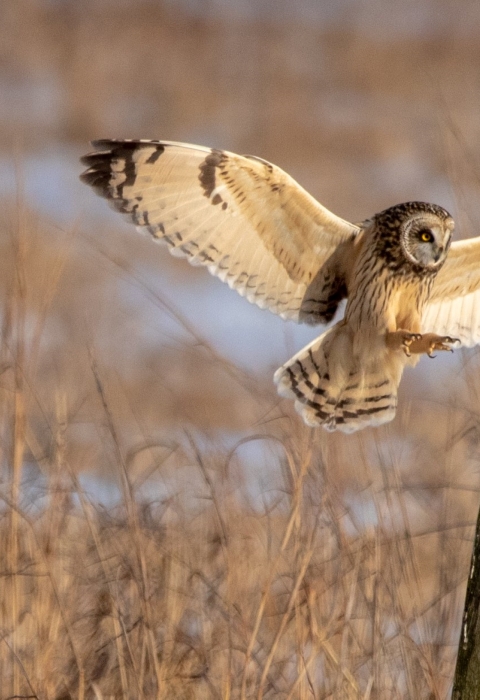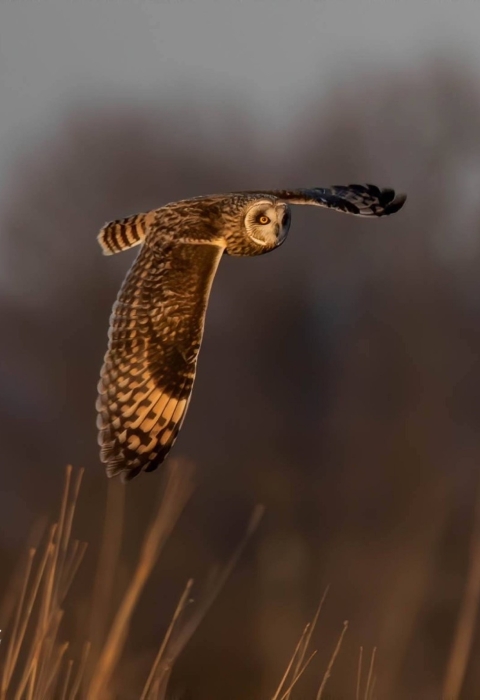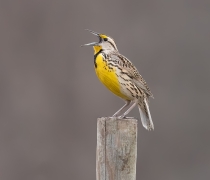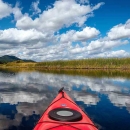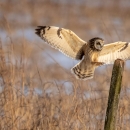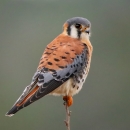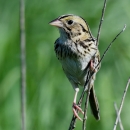Written by: Susan Logan Ward Town of Newburgh NY Shared here with permission from the New York State Ornithological Association
Shawangunk Grasslands National Wildlife Refuge in Ulster County is my favorite place to observe birds and photograph their beauty. This spectacular Refuge once was the Galeville Military Airport, a marshland that the U.S. Army filled in with soil and transformed into an air base after WWII. It was used as a training site for FBI agents, the U.S. Marshals Service, and military academy members. The airport was officially closed in 1994 and then taken over by the U.S. Fish & Wildlife Service (USFWS) in July 1999. USFWS covered the runways with a deep layer of soil, planted native warm season grasses and wildflowers, and established the site as a National Wildlife Refuge, thereby protecting its 597 acres to support grassland-dependent migratory birds and wintering raptors.
This refuge is among the diminishing number of sites in New York State large enough to support the entire assemblage of northeastern grassland birds. Audubon New York identifies it as one of more than 130 Important Bird Areas (IBA) in the state. Each recognized IBA meets at least one of three criteria: A place where birds congregate in large numbers at one time; a place for species that are at-risk; or a place that supports groups of birds representing certain habitats such as forests, wetlands, grasslands, and shrublands. Among the birds found in the Refuge’s grassland habitat are species included on lists of endangered, threatened, priority, or special concern, such as Short-eared Owl, Northern Harrier, Grasshopper Sparrow, Vesper Sparrow, and Bobolink.
The Refuge’s years as a military airport and transformation to a National Wildlife Refuge far precede my 2015 initial visit. It was love at first sight and I began showing up nearly every day to see what I might find. In 2017, a USFWS staff member invited me to become a volunteer at this special place. I am privileged to continue volunteering since that time.
The Shawangunk Grasslands is especially known for its wintering raptors, which include Northern Harriers, Rough-legged Hawks, and the star of the coldweather months, those magnificent Short-eared Owls. There’s often a young harrier sporting a lovely cinnamon-spice colored breast in the Grasslands during the summer but wintering harriers generally start arriving in September and October. I saw at least 11 harriers in the air all at once this winter of 2023-2024; others reported 20 or more harriers this past season. There are far fewer “roughies” wintering in the Refuge; I believe there were two this past season. The first one spotted was a gorgeous dark morph on 2 November. Reports of the Shorteared Owls’ arrival typically range anywhere from the last couple of weeks in October to mid-November. This past winter, the first “shortie” was seen on 26 October with reports of at least 13-15 later in the season. Along with the wintering raptors arrive many human visitors who observe and photograph them. To minimize disturbance to wildlife, from 1 December through 31 March USFWS closes a significant portion of the approximately 3.6- mile trail system. Visitors may still safely and successfully observe and photograph the owls and other raptors from the abbreviated trails, observation platform and designated area around it, main parking area, and the beautiful gazebo. Benches along the trails and other areas of the Refuge provide pleasant resting spots. With so many folks visiting at this time of year and just 45 parking spots in the main parking area, when capacity has been reached USFWS may direct people to park in the lot at the entrance or a small overflow parking area opposite the pole barn. Once all spots are filled, visitors will then be redirected to the town park adjacent to the Refuge. The park has no access to the Grasslands in winter, but there’s a good view of the Refuge from it and owls and harriers may be observed from there. It’s also a great location to spot a Rough-legged Hawk. There’s no doubt that the Short-eared Owls are incredible to watch! But my favorite winter visitor is much smaller. I just love sparrows and watch and wait for American Tree Sparrows to arrive in November. They often can be found foraging on the trail close to the Refuge pond or nearby along the driveway. At this time of year, you may find a Winter Wren or Golden-crowned Kinglet in this spot, too. Warm weather months are a different story at the pond, of course, with Great Blue and Green Herons sometimes spotted hunting for frogs and other pond-dwellers, and the occasional Belted Kingfisher. It’s a catch-and-release pond with largemouth bass and a variety of bluegills in it. I know of at least one instance where a fisherman looked down at some commotion near his feet and saw it was a Virginia Rail with her babies running helter-skelter. Mammals that have been seen near the pond include Red Fox, Gray Fox, Mink, Fisher, Raccoon, and White-tailed Deer; there are also Coyotes in the Refuge. Walking the pond trail in spring brings a good chance of Yellow Warblers, Yellow-rumped Warblers, Palm Warblers, Blue-winged Warblers (the Blue-wingeds breed in the Refuge and also may be found near the bee yard along the driveway), Red-eyed Vireos and less frequently, a Blue-headed Vireo. A bit past the pond is a great location to check for Swamp Sparrows.
But let’s go back to winter. If you stop near the pond to look for the Tree Sparrows and then walk across the driveway to the nearby feeder station, you’ll find numerous American Goldfinches, House Finches, Black-capped Chickadees, and Tufted Titmice. Downy, Red-bellied, and the occasional Hairy Woodpecker all frequent these feeders; in an irruption year this feeder station is a good spot for Common Redpolls and Pine Siskins. There’s a mealworm feeder here that attracts Carolina Wrens and Eastern Bluebirds. You’ll also find quite a number of Whitethroated Sparrows. I observe a few of these sparrows in the wooded section of the Refuge year-round but they are very much in evidence in winter, singing their plaintive song and ground feeding on the seeds below the feeders. On the subject of sparrows, some Savannah Sparrows overwinter in the Refuge. A great place to look for them during the cold weather is the brush pile at the feeder station adjacent to the observation platform.
Most years there’s a male American Kestrel who chooses to overwinter in the Grasslands. This past season has been no exception, and this colorful little gentleman was frequently seen watching for prey from the driveway’s crabapple trees, perched above the nearby Purple Martin house, or hovering above a field. Kestrel sightings begin to pick up with more arrivals in March and pairs soon choose their own among the Refuge’s five kestrel boxes. Each year it’s hoped that all the boxes will be occupied and young produced.
Short-eared Owls depart the Refuge for their northward migration anywhere from the end of February to early April. I’m unsure whether the Short-ears seen toward the latter part of this timeframe are here throughout the winter or are passing through from another location. They’re not the only owls in the Refuge, though, as there are Barred Owls in the woods along the driveway and adjoining the nearby horse farm. This past winter, Great Horned Owls were regularly heard and occasionally seen at day’s end.
A word about an annual event that takes place after the Short-eared Owls have left: Each year, USFWS conducts a controlled burn on the grassy areas in the Refuge. The burn area may total around 200 acres and its objective is to ensure that the area continues to provide valuable foraging and nesting habitat. As explained to me when I first started visiting the Refuge, if there was no burn, then there would be no grassland; the open fields would revert to the woodland and other vegetation that one sees throughout the local area. The takes place between the time the Short-eared Owls have departed and Bobolinks arrive; it is a concerted effort among USFWS and various wildland firefighting agencies. The Refuge is closed to visitors during this burn, and the date it takes place depends on many factors, including wind speed and direction, relative humidity, and fuel moisture.
As early as February, Red-winged Blackbirds signal that Spring will soon be here by singing “Conk-a-lee!” Then in March, just around the time that the American Tree Sparrows start to head to their northern nesting grounds, Tree Swallows begin to arrive. They’ll begin pairing up in April for nesting season. Eastern Bluebirds are a favorite in the Refuge. Many overwinter and more will begin arriving in March and April. The Refuge has upwards of three dozen bluebird nest boxes, with many installed in pairs so that tree swallows may inhabit one and bluebirds the other. It doesn’t always work out that way—and sometimes the boxes are inhabited by House Wrens—but it’s wonderful that most boxes are successfully occupied.
At the beginning of April, USFWS reopens all the trails, permitting visitors to walk throughout the Refuge. Vegetation includes native warm-season grasses such as switchgrass, Indiangrass, little bluestem, and big bluestem. If your walk takes you near an area that was burned, you may be amazed to see how quickly these grasses regenerate; they will be peeping their heads above ground within just a few days. Wildflowers blooming at various times throughout the warm weather include Virginia Meadow Beauty, Ragged Robin, Blue Vervain, False Dragonhead, New England Aster, Canada Goldenrod, Black-eyed Susan, Ironweed, Penstemon, Musk Mallow, St. Johnswort, Creeping Thistle and Bull Thistle, and Common, Swamp, and Purple Milkweed. The milkweeds are particularly important as they are host plants for Monarch butterflies; of the three, Common Milkweed is especially abundant. The late-summer fields of goldenrod mixed with asters are stunningly beautiful, but penstemon may be my favorite of all. When it blooms throughout the Refuge in June, swaths of its white blossoms look like snow has fallen on the open fields, and its fragrance at the end of each day is heavenly. I often see hummingbirds visiting it along the driveway.
Among the insects you may find during the warm-weather months are butterflies and moths such the beautiful Monarch and lookalike Viceroy; Clouded and Orange Sulphurs; Eastern Tailed-Blue; Painted Lady; Red Admiral; Tiger, Black, Spicebush, and Giant Swallowtail; and Hummingbird and Snowberry Clearwing Moths. Ulster County Beekeepers Association maintains an apiary along the driveway. If your visit coincides with a day the beekeepers are tending the hives it is fascinating to watch. And there are many grasshoppers in the Refuge! Especially in August, you might see American Kestrels perch on the parking lot signage, swoop down to grab a grasshopper, and bring it back to the sign to devour it. If you have a bit of time to spend, you can watch them do this over and over again.
Late April and May bring the arrival of Purple Martins, Eastern Kingbirds, and Grasshopper Sparrows. The Refuge has a martin house near the entrance drive; last year this communal roost was especially well-attended by these gorgeous swallows. It’s delightful to watch each parent bird perform aerial acrobatics to snap up insects from the air, zoom in to their respective nesting cavity to stuff the insect in a baby’s wide-open mouth, and then fly right back out to do it all over again. Eastern Kingbirds often nest in the crabapples near the driveway; they perch on the signs along it and sally out to seize insects from the air to feed their young. Of all the birds throughout the entire year, though, the Grasshopper Sparrow is my favorite. Some may find them plain, but the longer one looks at them, the more beautiful their plumage appears. They’re easiest to spot when they first arrive and the vegetation hasn’t grown tall and dense. Males are then often seen atop grasses and small bushes, singing their buzzy song. I love watching them! It’s a privilege to observe these special birds at length, and to see them forage and feed their young throughout the summer.
Early May brings Bobolinks, one of the gems of the Grasslands. Males arrive first, with buffy-colored females flying in a week or two later. Especially beautiful are the males that arrive in not-quite breeding plumage: They still have a bit of their tawny winter feathers showing and to me it looks like they’re speckled with golddust. It’s fascinating to watch the Bobolinks, as the males sing their bubbly song and stake out their territories before the females arrive, and then court and chase the females before they settle down to nest in the grasses. In late summer as they prepare for migration, the males lose their breeding finery and molt into plumage similar to the females. It’s wonderful to view them in their patchwork colors as the molt takes place.
Arriving in May is another of my tiny favorites, the Willow Flycatcher. They can be seen throwing back their heads as they sing “Fitz-bew!” and later in the season foraging to feed their babies. It’s interesting to me that each season some of these flycatchers perch and sing from the exact same spot on the exact same branches as the year before.
Eastern Meadowlarks are a cherished sight and sound of the Grasslands. There are always at least a dozen or so that overwinter in the Refuge, but the majority of the meadowlarks are migration arrivals in April and May. They’re easy to spot at that time even from the parking lot, which is, by the way, a portion of a runway remaining from the Refuge’s previous military airport days. Meadowlarks often perch atop the gazebo, along the observation platform’s railing, or on one of the nearby fenceposts. In Spring, their flutelike song can be heard throughout the Refuge. Any discussion of the Grasslands must include the rarities that sometimes appear. Quite notably, a Loggerhead Shrike was reported in winter 2022-23, and then reported again beginning in summer 2023, with reports continuing even as this goes to press in mid March 2024. In summer 2017, a Henslow’s Sparrow delighted many visitors; twice as thrilling was a pair of Henslow’s the following summer. They’ve not been reported since but each summer there’s hope they’ll visit again. A Black-crowned Night-Heron was seen last May; occasionally, a Dickcissel may be found in summer. In November 2022, I reported an Eastern Meadowlark in eBird and included its photos—and then the sharp-eyed expert reviewers contacted me to say it was instead a Western Meadowlark! I’m so grateful for their identification, especially as this was the first record for Ulster County and only the second for Region 9. Per eBird, 201 species have been reported in the Grasslands, so there are many I’ve not mentioned and one never knows what delightful surprises may be found in this remarkable Refuge. All the more reason to visit it every day!
When summer edges its way into August, many of the grassland birds are wonderful to observe in immature or non-breeding plumage, or gathering into flocks before heading out in migration. Before one knows it, it’s September and October: Time again for another favorite, Lincoln’s Sparrows, to stopover in the Refuge for a bit before heading further south. I spent this past October happily watching these beautiful sparrows. And then toward the end of the month, that very first Short-eared Owl of the season was spotted! With that, so began the shift into another season of watching for winter raptors.
If you choose to visit the Shawangunk Grasslands, please keep in mind it is open daily from sunrise to sunset; there’s a public restroom but no potable water sources. One must beware of poison ivy, ticks, and other biting insects; stay on the maintained trails or observation platform and surrounding area; and observe wildlife from a safe and respectful distance. Binoculars, spotting scopes, and cameras with long lenses allow you to observe wildlife closely without disturbing them. I’m at the Refuge most mornings; please feel free to stop and chat and let me know if I may be of any assistance. It would be my pleasure to point out some of the treasures found in the remarkable Shawangunk Grasslands.
